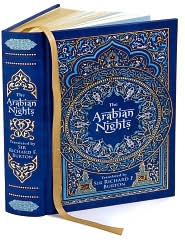Bookbinding is the process of assembling a book. This sounds quite straight-forward—but bookbinding is complicated. The materials used have changed over time allowing for developments in the methods used to make books, yet many of the methods used today date back centuries.
To summarize modern bookbinding we are using the method of joining pages and a cover as our basis for classification, and thus, the title of this post.
Stitched
Stitched books are those the pages of which are sewn together at the spine. This method of binding dates back to the first century AD when the Coptic Christians of Egypt used folding sheets of vellum or parchment and sewed them through the fold to create the interior of early books called codices. In this way they achieved a manuscript on which text could be printed on both sides of the page. In this sort of early codex, wooden boards held the pages together and the work was then slipped into a leather bag to be carried.
Most hardcover books are stitched, joining leaves of multiple pages together and then through cords that are attached to the cover. The cover on such books is, as the name implies, hard, often covered in leather or cloth. If you look closely at the center of the pages of a hardcover book you can find the sticking at intervals of every 8 to 16 pages, a leaf being 4 to 8 sheets of printed material folded in half and creating 8 to 16 physical pages, printed on both sides, thus 16 to 32 numbered pages.
Here is a picture of a beautiful example of a modern hardcover book. It is a Barnes & Noble, Inc. production of the classic The Arabian Nights, translated by Sir Richard F. Burton. It was published in 2009.
Some hardcover books are actually produced using a glued method of joining the pages; the pages are then clued to a hardcover. Bookbinding done with adhesives is usually, however, a method used for binding paperback books.
Punched
What we refer to as punched bookbinding covers both spiral and plastic-coil binding. In both of these methods, holes are punched along one side of each sheet, or each leaf of pages. The pages are then joined by either a metallic coil wound through these holes or a plastic comb-like rod that is threaded through the holes.
Here is a picture with a sample of a book bound by each of these methods.
For the most part, this binding method is used for manuals, cookbooks and other such manuscripts that benefit from being left open on a surface for reference. Some people would not consider a book bound in this fashion to be a “real” book.
Glued
With advances in modern chemistry and the development of sophisticated adhesives, a new method of bookbinding came into being. Bookbinding based on gluing is referred to as “perfect” binding. Pages are assembled in much the same way as is done with the stitching method, but the leaves are drawn across a blade so that notches may be carved in the bound edge. The resulting rough spine is passed over a hot-melt glue dispenser. The glue works its way into the notches joining the leaves and creating the spine which is then glued to the cover. If you open a paperback book you can often make out the pattern of the notches that were cut into the leaves—by means of which the glue was forced in joining them together. But don’t open the book too vigorously or you may actually damage the joint. Most of us will remember somebody in our lives who admonished us not to “leave that book laying open—you’ll break the spine!”
Perfect binding was invented in the late nineteenth century but was not commonly used until the 1930s when paperback books began to appear in good numbers. In the 1940s the DuPont Company developed a binding process based on a hot-melt adhesive. This new perfect binding system produced a far more durable and long-lasting book than earlier cold glues could, used up to that time in perfect binding, could manage.
Perfect binding systems have come a long way and now make it possible for books to be printed on demand.
This quick summary barely touches the surface of the art of bookbinding. It has a rich history and each of the methods described can be implemented in many different ways using many different materials. The Queensland Bookbinders’ Guild in Australia provides a rather impressive listing of books on the topic; you may wish to study them here.
It is very apparent to us all what an immense difference there is in the binding of the various books in our own possession, both in the elements of strength, good forwarding, and beauty of decoration, but equally so in the ease or difficulty with which certain books are opened and held in position while reading them.
This excerpt is from a New York Times article dating to January 13, 1900. The first paragraph of the article is lost now, as is the author’s name, and yet, the rest of the article is available in PDF format, here (the wonders of the web!). It is a reminder of how things have changed in bookbinding and yet … how the essence of the matter is much as it has always been. What is important in bookbinding are durability, beauty, the quality of the materials used, and the ease with which the book may be read. It’s all about the reading after all.
Filed under: Bookbinding, Books - Physical |






A stitched books is definitely the most reader-friendly in my view, but also probably the more expensive. Most books, even some hardcover ones, are now glued. And that is why I have acquired several book weights that allows me to read without having to break the spine or hold the book firmly in my hands.
Thanks for making this so nicely clear.